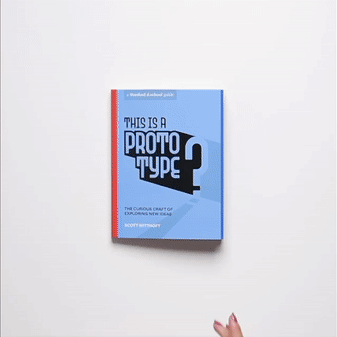
Prototyping Q&A with Deborah Carter
The following question and answer discussion comes from Deborah Carter. It resulted from a prototype experience I called, “27/7,” in which I asked seven questions about prototyping to 27 people I know or know of, admire, wondered about, and otherwise respect. The intent of the experiment was to understand better what the terms “prototype” and “prototyping” mean to a wide orbit of design professionals, with outcomes hopefully helping a book I’m writing about… prototyping. This discussion is the second in the series of content resulting from that experiment.
A few notes about Deborah:
Deborah Carter is, among her many other accomplishments, the founder of NewTechKids, a Netherlands-based organization with a self-defined mission of ensuring that, “students have a solid foundation to understand technology and the thinking and problem-solving behind it.” I met Deborah in Amsterdam in the context of her early entrepreneurial and design work with THNK, a then-emergent school for design leadership. Deborah’s current work introducing design to young people while cutting across lenses of affluence, ethnicity, and experience has continued to inspire me to look at the ways people learn about and encounter design as a foundational part of what they do next. To this end, I appreciate her combined responses to the following Questions 6 & 7 which include her observations of socio-economic situation and gender regarding the programs she designs and delivers. Her current work is also an illuminating example of partnering with a public library as a platform for advancing the capacity of a populous, auditioning the library as a resource beyond books. As with everyone I engaged in this experiment, I am grateful for her willingness to share her time and corresponding thoughts.
Questions 1 and 2: “Prototype” has a literal definition and has lots of implications — what do you think it communicates well? Where is it a total miss?
Deborah Carter: “Prototype” communicates well that you are designing an initial version of something which will evolve over time through testing, iteration and general insights. For kids, it’s really hard to communicate that the importance of prototyping is not the finished product but rather the process of getting to the finished product. This is such a contrast to the rest of the normal schooling which is all about delivering final products and not submitting failed or incomplete work.
Q3: How does prototyping show up differently in your personal versus professional life? (… or your recreational life or experimental life?)
DC: Honestly, I don’t do much prototyping with tangible objects. My prototyping has more to do with curriculum and lesson development and the development of lesson materials which encourage kids to think critically about technology. Each of NewTechKids’ lessons or workshops are based on prototyping: we use our pedagogy and teaching approaches as a framework to develop, test and iterate our lessons continuously. Prototyping has helped us transform our teaching approaches to better engage girls, kids of colour and kids from low-income backgrounds with computer science, programming and design. Prototyping has also helped us shift from a more technical approach to computer science and programming to one that it more focused on computational thinking.
Q4: Thinking of a recent project in which intentionally you used a prototype — whether a challenge or a breeze — what were ways you knew if the prototype was going well or poorly?
DC: NewTechKids is collaborating with the Amsterdam Public Library to develop a hybrid learning program which blends computer science and programming with digital fabrication (graphic design with software, 3D printing, laser cutting, vinyl cutting, etc.). This week’s program is our third iteration. [Ed. note: late 2019] We know that the programs are effective based on several factors: student engagement, student feedback, the quality of student prototypes and feedback from parents.
Q5: What’s a go-to prototyping tool you use most regularly? (Please feel easy interpreting “tool” loosely — object, state of mind, constraint, whatever…)
DC: In the context of computer science and programming for primary school students (ages 7–12), we are big fans of LEGO WeDo and LEGO Mindstorms. LEGO gets it: we can teach basic foundational skills such as physics and mechanics as well as programming concepts. These robotics kits offer kids the chance to design and build something physical and then program it. It’s the trade-off between hardware and software where the valuable learning takes place. You can have the best robot but the programming doesn’t work. Or you can have the best code but it doesn’t match the robot you’ve built. What do you change? Why?
Q6: What’s missing from the discussion of prototyping?
Q7: What’s a change in how you think of prototyping *now* contrasted to how you may have thought/acted in the past?
DC: Too often, people describe prototyping in terms of an unstructured process during which items are designed by chance. Prototyping will become a more effective learning tool if it is taught as a structured, deliberate process with specific steps and evaluation tools used during the process. Also, prototyping needs to be studied in terms of how it influences mindset. Does a student who prototypes often have different attitudes towards things like experimentation, failure, perseverance, risk-taking, etc.?
Another point is the link between prototyping and diversity/inclusion. Over our five years of teaching computer science, we have noticed that girls, minority and low income kids receive far less exposure to prototyping exercises than (usually white and Asian) boys. Boys are exposed to prototyping activities early and throughout their childhood (playing with wooden blocks, LEGO, building models and doing DIY activities with their dads or other men). This introduces them to physics, mechanics and most importantly, the mindset needed to respect the value of prototyping. For the other groups, they experience prototyping for the first time when they join our programs. (We teach in Amsterdam’s poorest neighbourhood and our students literally try LEGO for the first time in our programs because their parents either are too poor to buy LEGO and building toys or they choose not to.) We’ve actually adjusted our programs to focus heavily on designing and prototyping and getting into the mindset before we even introduce computer science concepts.
It’s not just poor students. We also teach for EF Tours which is a global company that caters to wealthy students from around the world. The girls in these programs also come to our workshops at a huge disadvantage and because of learned helplessness, they sit there and wait for our teacher to rescue them. We now give them extra instruction, do extra, short design lessons which introduce basic physics and mechanics and provide them with step-by-step building instruction booklets. This helps them ‘catch up’ with the guys. The effect has revolutionized their experience: dealing effectively with their prototyping barriers has allowed them to ‘catch up’ with the boys. Now we are seeing that the thinking and problem-solving behind their prototypes are often more well-thought out than their male peers.
Follow me here on Medium + check out my design newsletter on Linkedin.
Buy the book, This Is a Prototype, here.

